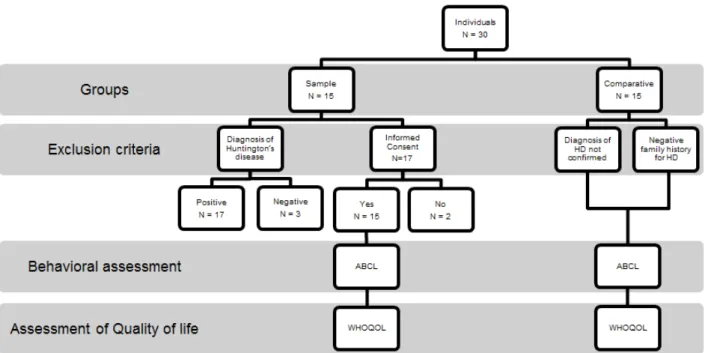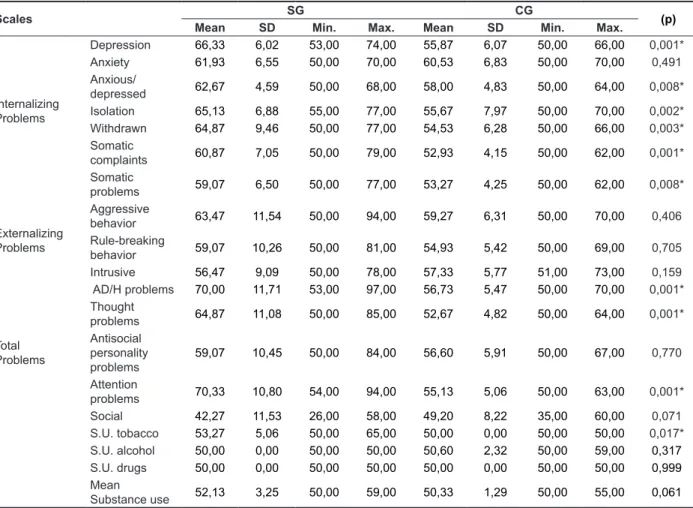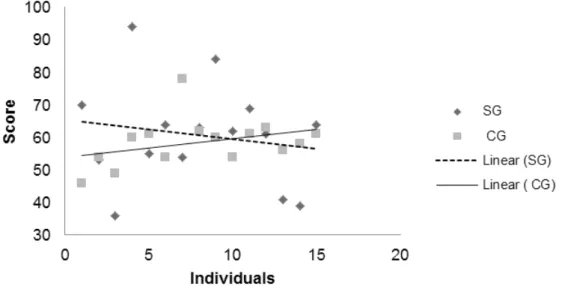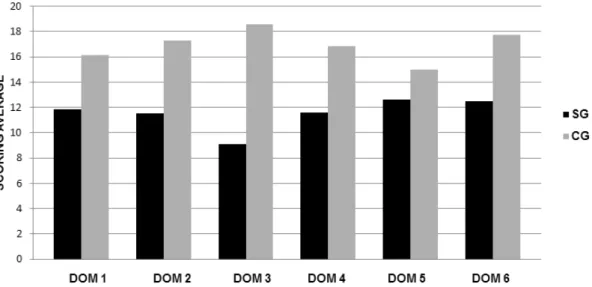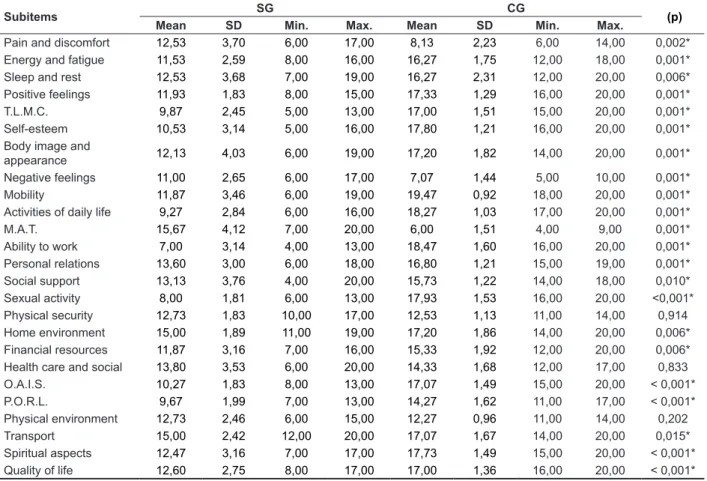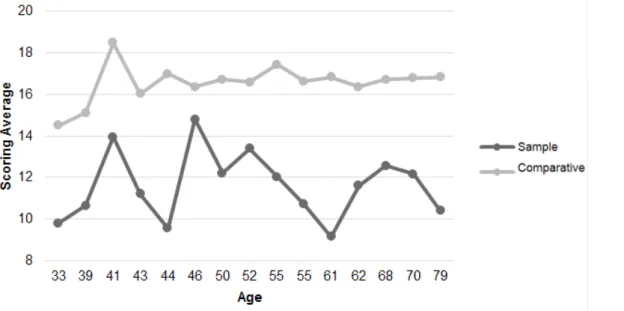BEHAVIOR, SOCIAL COMPETENCE AND QUALITY
OF LIFE IN HUNTINGTON’S DISEASE
Comportamento, competência social e qualidade de vida
na doença de Huntington
Caroline Stephanie da Silva (1), Tâmara Andrade Lindau(1), Célia Maria Giacheti(1)
(1) Universidade Estadual Paulista – UNESP, Marília, São
Paulo, Brasil.
Institute: Speech, Language and Hearing Science Department, Philosophy and Science College of Sao Paulo State University– UNESP, Marilia, SP, Brazil.
Support of the Sao Paulo State - FAPESP (Process nº 2013/03002-4)
Conlict of interest: non-existent
genetic testing1-3. However, Henley and colleagues
(2009) showed that changes in brain volume and the neural connections may be present before the onset of symptoms4.
The prevalence of this condition is estimated at 1 per 10,000 or 20,000 individuals, but with variations
in diferent regions and ethnic groups3.
The phenotype of HD is characterized by impair-ments in motor skills (e.g., tic moveimpair-ments, changes
in gait, stifness, etc.), cognitive skills (e.g., deicits in
visual memory, auditory, verbal and attention), and behavioral changes, psychological and language 1-3,5. The decline of oral language, receptive and
expressive level, can be triggered by two factors:
neurodegeneration and motor disorders6,7.
Issues relating to behavioral changes described in DH seem to be related both to the progressive cognitive decline as the psychological changes,
including depression, anxiety, irritability and apathy
INTRODUCTION
Huntington’s disease - HD - (OMIM #143100; ORPHA399), described by George Huntington in 18721-3, is a neurodegenerative condition, with
autosomal dominant inheritance, caused by an
expansion of CAG repeat in the huntingtin gene,
located on the short arm of chromosome 4 in the region 16.3. The diagnosis is performed by the presence of progressive motor and cognitive
symptoms, positive family history and is conirmed by
ABSTRACT
Purpose: to investigate the behavior, the social competence and the quality of life of subjects with Huntington Disease (HD). Methods: the sample was constituted of 30 participants, from 33 to 79
years old, divided in two groups: 15 participants in the experimental group (EG), who were previously
diagnosed with Huntington Disease and 15 participants in the control group (CG), equally paired according to age and education. The Behavioral Inventory, constituted by the Adult Behavior Checklist and the Quality of Life Questionnaire WHOQOL – 100 were used to assess the caregivers. Results:
the Behavioral Inventory showed statistically signiicant diferences for the EG when compared to the CG, with high scores for internalized factors (anxiety, depression, isolation, somatic complaints), total
problems and other problems as thinking, attention and hyperactivity, according to their caregivers
opinion. In the Quality of Life Questionnaire the EG presented statistically signiicant diferences when
compared to the CG, in all areas (physical, psychological, level of independence, social relationships, environment and religious aspects). In most of the assessed aspects EG presented low average of quality of life, while the CG presented high average. Conclusion: subjects with HD present behavioral,
social competence and quality of life diferentiated and altered proile, according to their caregivers,
when compared to CG. HD is a limiting, progressive disease that seems to be responsible for the set of behavioral, social competence and quality of life changes reported by their caregivers.
Huntington’s disease: Quality of life
1793
complaints, somatic problems, withdrawn; (2)
externalizing - aggressive behavior, rule-breaking
behavior, intrusive; (3) Others- antisocial personality problems, thought problems, attention/hyperactivity problems.
Evaluation of Quality of Life
The Quality of Life Questionnaire WHOQOL-10019 lists a number of issues relating to the family
or caregiver vision on quality of life and health of the individual, and for each respondent marks the frequency with which these problems occur.
For this, the WHOQOL-10019 evaluates six
domains, consisting of 24 sub-items, as follows: (1) Domain 1 - physical, composed of sub-items “pain and discomfort”, “Energy and fatigue” and “Sleep and rest”; (2) Domain 2 - psychological, consisting of sub-items “Positive feelings”, “Thinking, learning, memory and concentration”, “Self-esteem”, “Body image and appearance” and “Negative feelings”; (3) Domain 3 - level of independence, composed of sub-items “mobility”, “Activities of daily life”, “drug addiction or treatment” and “Ability to work”; (4) Domain 4 - social relations “personal relations”, “
social support “ and “sexual activity”; (5) Domain 5
- environment, consisting of the sub-items “Physical security and protection,” “Home environment”,
“inancial resources”, “Health care and social: avail -ability and quality,” “opportunity to acquire new infor-mation and skills” “Participation in and opportunities for recreation / leisure”, “Physical environment:
pollution / noise / traic / climate” and “Transport”;
and (6) Domain 6 - spiritual aspects / religion / personal beliefs, consisting of sub-items “Spirituality / religion / personal beliefs.”
Figure 1 presents the selection phase, according
to criteria of inclusion and exclusion, as well as the
assessment procedures used in this study.
DATA ANALYSIS
The analysis of data collected by the Behavior Inventory was performed using the Assessment Data Manager Software (ADM), which is the program developed for analysis of this procedure20.
In addition to this analysis, the data collected by are the most frequent in these individuals compared
with healthy individuals8-10.
Regarding quality of life, there are reports of
suicide justiied by depression and physical depen -dence caused by the impact of symptoms on daily activities11,12.Therefore, the DH impairs the mental
health of individuals and may be observed sufering
and emotional stress among family throughout the course of the disease13,14.
Although literature has studies on the behavioral aspects related to DH, few studies are conducted
on the behavioral proile, social competence and
quality of life of these individuals8,10,12,15-17.
Therefore, this study aimed to investigate the behavior, social competence and the quality of life of individuals with Huntington’s disease, according to the opinion of their caregivers.
METHODS
The study was approved by the Research Ethics Committee of UNESP - Marilia, under the protocol number 0710/2013, and participants signed the Informed Consent (IC).
The participants were 30 individuals of both genders, with age between 33 and 79 years. The individuals were divided into two subgroups: sample group (SG) consisting of 15 individuals with a diagnosis of Huntington’s disease; and control group (CG), consisting of 15 i individuals without diagnosis or symptoms and negative family history for HD.
For inclusion of SG, were considered: diagnosis of Huntington’s disease and signing the Informed
Consent. Longer as exclusion criteria were considered: not conirmed diagnosis of HD, comor -bidity with other disorders and individuals who refused to participate in the study.
Behavioral Assessment and social competence
To investigate the behavior and social
compe-tence (e.g., aggressive behavior, anxiety /
depression, social problems, etc.), it was applied the Behavioral Inventory consisted of the Adult Behavior Checklist (ABCL)18 in caregivers (i.e.,
The attitudes that compose such scales are presented in Table 1 in an isolated manner, which also presents the comparison between SG and CG in all ABCL scales.
After analyzing the isolated behaviors, it was carried out analysis of the set of behaviors grouped to form the scales. Figure 2 demonstrates the
perfor-mance proile of the individuals of the SG and CG
regarding Internalizing Scale. Figure 3 shows the
same proile in relation to Externalizing Scale and
in Figure 4 compared to the Total Problems Scale.
RESULTS
Behavioral Inventory of Adult Behavior Checklist (ABCL)
The results obtained by this behavioral Inventory
ABCL were analyzed according to the score obtained for each of the eight scales isolated and
subse-quently grouped into Internalizing, Externalizing and
Total Problems Scales.
Caption: ABCL: Behavioral assessment questionnaire; WHOQOL: Quality of Life Questionnaire
Huntington’s disease: Quality of life
1795
TABLE 1. Comparison of results in behavioral scales ABCL in the sample and comparison groups, according to opinion of their caregivers
Scales SG CG (p)
Mean SD Min. Max. Mean SD Min. Max.
Internalizing Problems
Depression 66,33 6,02 53,00 74,00 55,87 6,07 50,00 66,00 0,001*
Anxiety 61,93 6,55 50,00 70,00 60,53 6,83 50,00 70,00 0,491
Anxious/
depressed 62,67 4,59 50,00 68,00 58,00 4,83 50,00 64,00 0,008* Isolation 65,13 6,88 55,00 77,00 55,67 7,97 50,00 70,00 0,002* Withdrawn 64,87 9,46 50,00 77,00 54,53 6,28 50,00 66,00 0,003* Somatic
complaints 60,87 7,05 50,00 79,00 52,93 4,15 50,00 62,00 0,001* Somatic
problems 59,07 6,50 50,00 77,00 53,27 4,25 50,00 62,00 0,008*
Externalizing
Problems
Aggressive
behavior 63,47 11,54 50,00 94,00 59,27 6,31 50,00 70,00 0,406 Rule-breaking
behavior 59,07 10,26 50,00 81,00 54,93 5,42 50,00 69,00 0,705 Intrusive 56,47 9,09 50,00 78,00 57,33 5,77 51,00 73,00 0,159
Total Problems
AD/H problems 70,00 11,71 53,00 97,00 56,73 5,47 50,00 70,00 0,001* Thought
problems 64,87 11,08 50,00 85,00 52,67 4,82 50,00 64,00 0,001* Antisocial
personality problems
59,07 10,45 50,00 84,00 56,60 5,91 50,00 67,00 0,770
Attention
problems 70,33 10,80 54,00 94,00 55,13 5,06 50,00 63,00 0,001* Social 42,27 11,53 26,00 58,00 49,20 8,22 35,00 60,00 0,071 S.U. tobacco 53,27 5,06 50,00 65,00 50,00 0,00 50,00 50,00 0,017* S.U. alcohol 50,00 0,00 50,00 50,00 50,60 2,32 50,00 59,00 0,317
S.U. drugs 50,00 0,00 50,00 50,00 50,00 0,00 50,00 50,00 0,999
Mean
Substance use 52,13 3,25 50,00 59,00 50,33 1,29 50,00 55,00 0,061
Caption: SA = sample group; CG= comparative group; SD: Standard Deviation; *p-value ≤0,005: statistically signiicant; Min: minimum; Max: maximum; AD/H problems: Attention deicit/hyperactivity problems; S. U.: substance use.
Caption: SA = sample group; CG= comparative group.
Figure 3 – Comparison of the results of ABCL between the sample group and the control group, according to externalizing factors
Caption: SA = sample group; CG= comparative group.
Figure 4 – Comparison of the results of ABCL between the sample group and the control group by total problems
WHOQOL Questionnaire
In the replies of the caregivers to the WHOQOL-100 questionnaire it was noted that there
were diferences in average score of between the
SG and CG groups in all domains (Figure 6). Figure 5 shows the change in average score of
Huntington’s disease: Quality of life
1797
Figure 5 – Comparison of the average overall score of the sample group and control group considering the age variable in ABCL behavioral Inventory
Caption: SA = sample group; CG= comparative group; DOM 1: physical; DOM 2: psychological; DOM 3: level of independence; DOM 4: social relationships; DOM 5: environment; DOM 6: religious aspects.
Table 2 – Comparison of sub-items of the WHOQOL quality of life questionnaire between individuals with and without Huntington’s disease, according to the opinion of their caregivers
Subitems SG CG (p)
Mean SD Min. Max. Mean SD Min. Max.
Pain and discomfort 12,53 3,70 6,00 17,00 8,13 2,23 6,00 14,00 0,002* Energy and fatigue 11,53 2,59 8,00 16,00 16,27 1,75 12,00 18,00 0,001*
Sleep and rest 12,53 3,68 7,00 19,00 16,27 2,31 12,00 20,00 0,006*
Positive feelings 11,93 1,83 8,00 15,00 17,33 1,29 16,00 20,00 0,001*
T.L.M.C. 9,87 2,45 5,00 13,00 17,00 1,51 15,00 20,00 0,001*
Self-esteem 10,53 3,14 5,00 16,00 17,80 1,21 16,00 20,00 0,001*
Body image and
appearance 12,13 4,03 6,00 19,00 17,20 1,82 14,00 20,00 0,001*
Negative feelings 11,00 2,65 6,00 17,00 7,07 1,44 5,00 10,00 0,001*
Mobility 11,87 3,46 6,00 19,00 19,47 0,92 18,00 20,00 0,001*
Activities of daily life 9,27 2,84 6,00 16,00 18,27 1,03 17,00 20,00 0,001*
M.A.T. 15,67 4,12 7,00 20,00 6,00 1,51 4,00 9,00 0,001*
Ability to work 7,00 3,14 4,00 13,00 18,47 1,60 16,00 20,00 0,001*
Personal relations 13,60 3,00 6,00 18,00 16,80 1,21 15,00 19,00 0,001*
Social support 13,13 3,76 4,00 20,00 15,73 1,22 14,00 18,00 0,010*
Sexual activity 8,00 1,81 6,00 13,00 17,93 1,53 16,00 20,00 <0,001* Physical security 12,73 1,83 10,00 17,00 12,53 1,13 11,00 14,00 0,914 Home environment 15,00 1,89 11,00 19,00 17,20 1,86 14,00 20,00 0,006* Financial resources 11,87 3,16 7,00 16,00 15,33 1,92 12,00 20,00 0,006* Health care and social 13,80 3,53 6,00 20,00 14,33 1,68 12,00 17,00 0,833
O.A.I.S. 10,27 1,83 8,00 13,00 17,07 1,49 15,00 20,00 < 0,001*
P.O.R.L. 9,67 1,99 7,00 13,00 14,27 1,62 11,00 17,00 < 0,001*
Physical environment 12,73 2,46 6,00 15,00 12,27 0,96 11,00 14,00 0,202
Transport 15,00 2,42 12,00 20,00 17,07 1,67 14,00 20,00 0,015*
Spiritual aspects 12,47 3,16 7,00 17,00 17,73 1,49 15,00 20,00 < 0,001* Quality of life 12,60 2,75 8,00 17,00 17,00 1,36 16,00 20,00 < 0,001*
Caption: SA = sample group; CG= comparative group; SD: Standard Deviation; *p-value ≤0,005: statistically signiicant; Min: minimum; Max: maximum;T.L.M.C.: Thinking, learning, memory and concentration; M.A.T.: Medication Addiction or treatments; O.A.I.S.: Oppor -tunity to acquire new information and skills; P.O.R.L.: Participation in and opportunities for recreation / leisure.
The average score of for the quality of life due to age was drawn, and as a result it is observed that the change in score for SG was greater than for the CG. In this regard the increase in age was not decisive for the increase in score (Figure 7).
Table 2 presents data comparing SG and CG
for all sub classiication that compose the question -naire on quality of life, where it appears that only
three sub-items had no signiicant diference when
Huntington’s disease: Quality of life
1799
Figure 7 – Comparison of average overall score of the sample group and control group considering the age variable in the WHOQOL
DISCUSSION
Using the data obtained from the Behavioral Inventory, it was observed that the SG when
compared to the CG showed statistically signiicant diferences in internalizing factors (Table 1, Figure
2) and total problems (Table 1; Figure 4), suggesting
that the behavioral proile with changes involves not
only the individual but also the environment where he is inserted, consequently showing losses in his social relation11-14.
Among the behavioral characteristics inves-tigated, there is high incidence of social isolation, avoidance, somatic complaints, somatic problems
and depressive feelings, the latter is a inding
that may also be observed in other studies and
identiied as responsible for the high rate of suicide
in individuals with HD15,21. Anxiety was also one of
the changes often mentioned by caregivers and is pointed as a major cause of problems in interper-sonal relationships of individuals with HD and their caregivers9,15,22,23.
Behavioral changes such as aggression (attitudes of mood swings, irritability and verbal or physical attacks on other people) was mentioned by 50% of the caregivers in this study. This data can
be justiied, according to literature, as a neuropsy -chiatric symptom unrelated to cognitive or motor
deicits and may have as a predictor anxiety16, 23-25.
so the higher the score the better the quality of life of individuals. According to the results, it appears that individuals with HD, when compared to healthy individuals, they had lower scores in all domains and global scope. These data are in agreement with
indings of previous studies that identiied in this respect, negative inluences of the disease since
the beginning of its manifestations, according to family / caregivers14,17,26.
Considering the diferent domains of assessment
of quality of life, it is emphasized that the SG had a
signiicant gap when compared to CG, showing that
the level of dependency can be seen as one of the factors that negatively impact the quality of life. The
indings of this study conirm the literature indings,
which register the presence of physical changes and functional impairment of the individual with HD as dependency factors, according to the progression
of the disease, afecting also their quality of life.
Therefore, they are responsible for overload of physical and mental work of family / caregiver14,26.
Given the data presented, it can be suggested
that HD causes signiicant behavioral changes in
impact of this disease, in relation to the advance of
symptoms, behavioral proile, social competence
and quality of life, according to the viewpoint of the individual himself with HD.
ACKNOWLEDGMENT
To the “Association Huntington Brazil” for their support in conducting this research and to all participants.
CONCLUSION
Individuals with HD have a behavioral proile
of social competence and quality of life distin-guished and with more changes, according to their caregivers when compared with the control group. Huntington’s disease is limiting, progressive and appears to be responsible for the set of behavioral, social and quality of life changes as reported by their caregivers. Complementary and cross-sectional studies could answer important questions about the
REFERENCES
1. OMIM (Online Mendelian Inheritance in Man). Johns Hopkins University; Inc.; 1966-2008. Disponível em: http://www.omim.org/entry/143100 2. Roos ACR. Huntington’s disease: a clinical review. Orphanet j. rare dis. 2010;5:1-8.
3. INSTITUTO NACIONAL FRANCÊS DE SAÚDE E INVESTIGAÇÃO MÉDICA. (Coord.). Orphanet: o portal para as doenças raras e os medicamentos orfãos. 2014. Disponível em: <http://www.orpha.
net/consor/cgi-bin/index.php?lng=PT>.
4. Henley SM, Wild EJ, Hobbs NZ, Frost C, Macmanus DG, Barker RA et al. Whole-brain atrophy as a measure of progression in premanifest and early Huntington’s disease. Mov. disord. 2009;24:932-6. 5. AMERICAN PSYCHIATRIC ASSOCIATION. Diagnostic and statistical manual of mental disorders: DSM-V. American Psychiatric Publishing, 2013.
6. Azambuja MJ. Contribuição ao estudo da linguagem em indivíduos com doença de Huntington [dissertação]. São Paulo (SP): Universidade de São Paulo; 2006.
7. Azambuja MJ, Radanovic M, Haddad MS, Adda CC, Barbosa ER, Mansur LL. Language impairment
RESUMO
Objetivo: investigar o comportamento, a competência social e a qualidade de vida de indivíduos com a Doença de Huntington (DH), segundo opinião de seus cuidadores. Métodos: constituíram a
casu-ística 30 participantes, com faixa etária de 33 a 79 anos, subdivididos em dois grupos: 15 do grupo
amostral (GA) diagnosticados previamente com Doença de Huntington e 15 participantes do grupo
controle (GC), pareados quanto à faixa etária, gênero e classiicação socioeconômica. Para avaliação destes sujeitos foram aplicados, em seus cuidadores, o Inventário Comportamental Adult Behavior
Checklist e o Questionário de Qualidade de Vida WHOQOL-100. Resultados: na avaliação do
com-portamento e da competência social, os sujeitos do GA apresentaram diferença estatisticamente
signiicante em relação ao GC, segundo opinião dos seus cuidadores, com escores elevados para fatores internalizantes (ansiedade, depressão, isolamento, queixas somáticas), totais de problemas e outros, como problemas do pensamento, atenção e hiperatividade. No questionário de qualidade de vida, para sujeitos com a DH também se evidenciou diferença estatisticamente signiicante em
relação ao grupo controle, em todos os domínios (físico, psicológico, nível de independência, rela-ções sociais, ambiente e aspectos religiosos) e na maioria dos subitens avaliados. O GA , apresentou
média baixa de qualidade de vida, enquanto o GC apresentou média alta. Conclusão: sujeitos com
DH possuem um peril comportamental, de competência social e qualidade de vida diferenciado e
com mais alterações, em relação ao GC, segundo os cuidadores . A Doença de Huntington parece
ser responsável pelo conjunto de alterações comportamentais, de competência social e de qualidade
de vida, relatado pelos cuidadores.
Huntington’s disease: Quality of life
1801
to individuals with Huntington disease. J. health psychol. 2013;18(2):212-25.
18. Achenbach TM, Rescorla LA. Manual for the
ASEBA School-Age Forms & Proiles. Burlington,
VT: University of Vermont, Research Center for Children, Youth & Families, 2001
19. WHOQOL Group. WHOQOL User Manual. Programme on mental health, 1998. Disponível em: www.who.int/.../who_qol_user_manual_98.pdf 20. Achenbach TM, Rescorla LA, Maruish ME. The Achenbach System of Empirically Based Assessment (ASEBA) for ages 1.5 to 18 years. In: Maruish ME, editor. The Use of Psychological Testing for Treatment Planning and Outcomes Assessment. New Jersey: Taylor & Francis; 2004. P.179-213.
21. Rosenblatt A. Neuropsychiatry of Huntington’s disease. Dialogues clin. neurosci. 2007;9(2):191-7. 22. Paulsen JS, Ready RE, Hamilton JM, Mega M, Cummings J. Neuropsychiatric aspects of Huntington’s disease. J. neurol., neurosurg. psychiatry. 2001;71:310–4.
23. Paulsen JS, Nehl C, Hoth KF, Kanz JE, Benjamin M, Conybeare R et al. Depression and stages of Huntington’s disease. J. neuropsychiatry clin. neurosci. 2005;17(4):496-502.
24. Reedeker N, Bouwens JA, Giltay EJ, Le Mair SE, Roos RA, Mast RCVD et al. Irritability in Huntington’s disease. Psychiatry res. 2012;200(2):813-8.
25. Nimmagadda SR, Agrawal N, Worrall-Davies A, Markova I, Rickards H. Determinants of irritability in Huntington’s disease. Acta neuropsychiatr. 2011;23(6):309-14.
26. Aubeeluck AV, Buchanan H, Stupple EJ. All the
burden on all the carers’: exploring quality of life with
family caregivers of Huntington’s disease patients. Qual. life res. 2012;21(8):1425-35.
in Huntington’s disease. Arq. neuropsiquiatr. 2012;70(6):410-5.
8. Cummings JL. Behavioral and psychiatric symptoms associated with Huntington’s disease. Adv. neurolo. 1995;65:179-86.
9. Duijin E, Kingma EM, Mast RC. Psychopathology
in Veriied Huntington’s Disease Gene Carriers. J.
neuropsychiatry clin. neurosci. 2007;19:441-8. 10. Thompson JC, Snowden JS, Craufurd D, Neary D. Behavior in Huntington’s Disease: Dissociating Cognition-Based and Mood-Based Changes. J. neuropsychiatry clin. neurosci. 2002;14:37-43. 11. Di Maio L, Squitieri F, Napolitano G, Campanella G, Trofatter JA, Conneally PM. Suicide risk in Huntington’s disease. J. medical. genet. 1993;30:293-5.
12. Helder DI, Kaptein AA, Van Kempen GM, Van Houwelingen JC, Roos RA. Impact of Huntington’s disease on quality of life. Mov. disord. 2001;16(2):325-30.
13. Williams JK, Skirton H, Paulsen JS, Tripp-Reimer T, Jarmon L, Mcgonigal KM, et al. The emotional
experiences of family carers in Huntington disease.
J. adv. nurs. Epub 2009;65(4):789-98.
14. Banaszkiewicz K, Sitek EJ, Rudzińska M, Sołtan W, Sławek J, Szczudlik A. Huntington’s disease from
the patient, caregiver and physician’s perspectives:
three sides of the same coin? J. neural. transm.
2012;119(11):1361-5.
15. Kingma EM, Van Duijn E, Timman R, Mast RC, Roos RA. Behavioural problems in Huntington’s disease using the Problem Behaviours Assessment. Gen. hosp. psychiatr. 2008;30(2):155-61.
16. Craufurd D, Thompson JC, Snowden JS. Behavioral changes in Huntington Disease. Neuropsychiatry neuropsychol. behav. neurol. 2001;14(4):219-26.
17. Carlozzi NE, Tulsky DS. Identiication of
health-related quality of life (HRQOL) issues relevant
http://dx.doi.org/10.1590/1982-0216201517621414
Received on: December 19, 2014 Accepted on: February 13, 2015 Mailing address:
